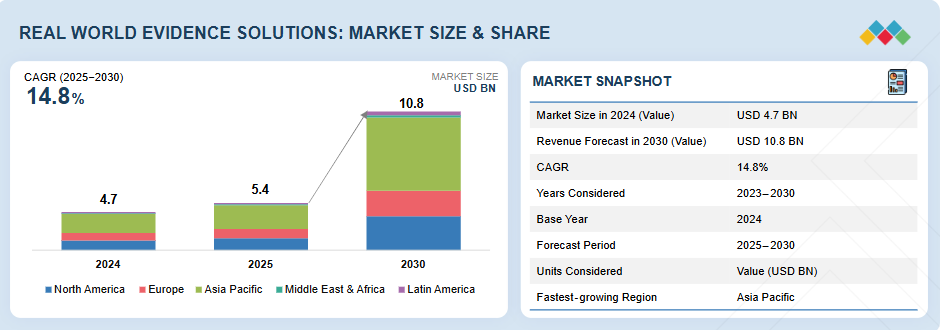The new reality of healthcare marketing is that it has quietly entered its hardest decade yet. The pressure isn’t about creative ideas anymore; it’s about proof, real evidence that campaigns, content, and engagement programs drive measurable outcomes. The global Real-World Evidence Solutions Market will rise from USD 4.74 billion in 2024 to USD 10.83 billion by 2030, growing 14.8 percent every year. Behind that surge is a massive shift: every major life-sciences company is racing to turn real world data in healthcare into a working engine for marketing, clinical, and commercial decisions.

What used to be a scientific back-office function like analysing post-trial outcomes, is now central to brand planning. But most marketing and digital leaders still face the same choke point: they can’t operationalise that data. They have multiple platforms, multiple agencies, and no single, compliant system that unifies it all.
That’s where execution, not strategy, defines the winners.
Why “More Data” Isn’t the Answer
Every Healthcare Marketing team today is surrounded by data: campaign metrics, prescription trends, CRM logs, call-center records, patient support data. But none of it lives in one place, and almost none of it talks to the clinical side. So, even with oceans of real world data in healthcare, decisions still rely on partial truths.
The problem isn’t lack of data. It’s lack of structure.
The real task now is to build the digital backbone, the platforms that can connect, clean, and interpret data in near real-time while staying audit-ready. That requires a different kind of marketing partner: one that treats technology as the core, not the afterthought.
Building the Tech Spine for Real-World Evidence
Turning raw data into business advantage demands three specific capabilities:
1. Data Integration and Interoperability.
Every dataset, whether it is EHR, CRM, marketing automation, or pharmacovigilance, must flow into a single governed ecosystem. The architecture needs APIs that allow two-way communication between commercial, medical, and regulatory systems. Without this layer, even the best analytics tools are blind.
2. Unified Customer View.
In Healthcare Marketing, “customer” means doctors, patients, pharmacists, and partners are all interacting differently. A unified customer view connects those interactions into one continuous profile. When a doctor reads a clinical article, attends a webinar, and later prescribes a product, the system knows. That’s the foundation for precision engagement and compliant personalization.
3. Analytics and Decisioning Layer.
This is where real world data in healthcare becomes operational. AI models identify correlations between therapy outcomes and engagement behavior. Dashboards highlight where education gaps exist. Predictive scoring tells marketing teams where to focus field resources or digital spend next.
When these layers work together, data stops being historical and becomes actionable.
The Next-Best Innovation Loop
The strongest global healthcare brands are now moving toward what’s known as “next-best” systems, which include real-time recommendation engines that guide every marketing and sales action based on evidence, not instinct.
In practice, that means when a cardiologist downloads a treatment paper, the system automatically triggers compliant educational content or schedules a rep follow-up. When adherence data shows a drop-off, the marketing automation adjusts patient messaging sequences.
This isn’t hypothetical. It’s built on AI models trained on real world data in healthcare, aligned with marketing triggers, and executed through composable cloud platforms. It’s what turns a static CRM into a live feedback loop, something traditional agencies and consultants simply can’t deliver.
How Healthcare Marketing Actually Uses RWD
Here’s what “tech execution” looks like on the ground:
A medical brand wants to understand why its diabetes program underperforms in Tier-2 cities. Instead of guessing, it links its EHR data, prescription data, and digital engagement logs through a cloud data lake. The integrated pipeline runs analytics that identify a treatment-education gap among younger doctors.
The marketing system automatically updates content journeys for that cohort, including localized, peer-reviewed, and compliance-checked. Within months, engagement metrics rise, conversion improves, and the insights feed directly back into the next campaign.
That’s how Healthcare Marketing should work. That’s how real world data in healthcare becomes real-world advantage by engineering systems that can sense, learn, and adapt.
Compliance by Design
In healthcare, one wrong data move can erase years of brand trust. That’s why compliance can’t be manual anymore; it has to be coded into the system.
Modern evidence frameworks use tokenisation, role-based access, and traceable audit logs so that every transaction from patient consent to content delivery is recorded and protected. This approach mirrors what’s happening globally: ICON’s 2025 tokenisation engine and Datavant’s acquisition of Aetion both point to a single truth: privacy and analytics can co-exist when built into architecture from day one.
Healthcare Marketing systems designed on those same principles allow marketers to operate faster without fear. Every email, asset, and campaign inherits compliance automatically. That’s the difference between a platform built for regulation and one constantly chasing it.
The Tech Execution Layer Most Teams Miss
Many marketing leaders outsource “data enablement” to analytics vendors, but analytics is the last step. The hard part is the plumbing, which means connecting content management, CRM, marketing automation, and evidence data through composable micro-services.
When done well, the payoff is enormous:
- No duplicate data entry across systems.
- Instant visibility of doctor engagement across channels.
- Automated reporting for MLR and UCPMP audits.
- Faster experiment cycles for new content or territory launches.
This execution layer is invisible to end-users but determines everything, from how fast insights surface to how easily campaigns scale.
Emerging Markets: India’s Advantage
Emerging economies like India, China, and Brazil are now the fastest-growing zones for Real-World Evidence solutions. India, in particular, has three unfair advantages: a massive patient population, rising digital maturity among hospitals, and government-backed EHR adoption.
But the infrastructure is fragmented. Healthcare Marketing leaders in India often operate across multiple legacy systems, like some cloud, some on-premises, some even spreadsheet-based. The real opportunity is to bring them together through modern integration frameworks.
Companies that build localised, language-ready, and regulation-compliant data ecosystems will move years ahead. They’ll own the feedback loop between patient behavior, physician practice, and marketing performance. That’s where India can lead, and not just follow, the global evidence revolution.
From Insights to Systems That Learn
The next phase of digital maturity in Healthcare Marketing isn’t more dashboards; it’s systems that learn. When evidence platforms and marketing clouds share the same data spine, machine learning models can predict which HCPs are likely to adopt, which markets are likely to expand, and which content formats drive sustained recall.
Those models then feed back into the content pipeline, shaping campaigns dynamically. Over time, marketing strategy evolves on its own evidence base.
That’s what “tech-led, execution-first” really means: designing marketing operations that improve every time they run.
The Unified View as a Growth Engine
The most underrated advantage of modern Healthcare Marketing technology is its ability to unify everything, including customers, content, and compliance, into one operational layer.
A unified view doesn’t just centralize data; it creates shared visibility. The medical team sees what marketing runs. The marketing team sees what the field force hears. Leadership sees what compliance clears. Everyone works from the same data reality.
This shared truth eliminates redundant approvals, improves brand consistency, and makes performance review objective. It’s not glamorous, but it’s what drives scale.
The How of Turning Data into Advantage
So, how do leading healthcare brands actually get from report to result? The answer lies in methodical tech execution:
- Start with architecture, not analytics. Build the data model first, mapping every source that matters from CRM to clinical trial data.
- Automate compliance upfront. Design workflows where every action triggers audit trails.
- Connect marketing and medical ecosystems. Integrate your evidence data with campaign systems so engagement decisions reflect real outcomes.
- Adopt composable platforms. Move away from monolithic tools to modular services that can scale and evolve.
- Measure what matters. Link RWE insights directly to marketing KPIs like HCP engagement, prescription intent, or adherence improvement.
These aren’t slogans; they’re the everyday mechanics behind the world’s fastest-moving Healthcare Marketing teams.
Looking Ahead
By 2030, the market for evidence-driven solutions will double again. Every Healthcare Marketing leader will have access to oceans of real world data in healthcare, but only a few will have the systems to use it intelligently.
The future belongs to those who build operational intelligence into their marketing stack. The ones who treat technology as an enabler of compliance, not a barrier. The ones who make data work for outcomes, not just reports.
Real-World Evidence isn’t a buzzword anymore; it’s the new foundation of healthcare growth. The question isn’t who collects it. It’s who executes it best.





